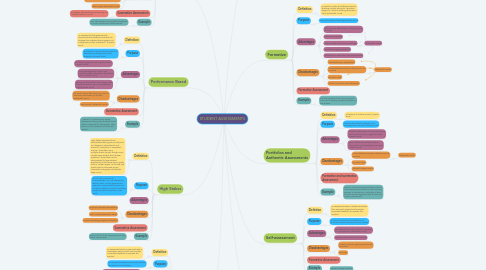
1. Summative
1.1. Definition
1.1.1. An assessment given after teaching and learning are complete of large content areas or units. (Renard, 2017)
1.2. Purpose
1.2.1. To assign grades and to evaluate student learning (Renard, 2017)
1.3. Advantages
1.3.1. provides students with extrinsic motivation for improvement, i.e., improvement with an aim of achieving a good performance in a test. (EduZenith, 2018)
1.4. Disadvantages
1.4.1. May be used for teacher evaluation (Renard, 2017)
1.4.2. the results come after learning so its too late inform the learner of the skill. (EduZenith, 2018)
1.4.3. Test anxiety (EduZenith, 2018)
1.5. Summative Assessment
1.5.1. it happens after teaching and learning are complete (Renard, 2017)
1.6. Example
1.6.1. Unit Test assesses various skills introduced in a unit, a summary of skills learned.
2. Performance Based
2.1. Definition
2.1.1. An assessment that systematically documents what children know and can do based on activities they engage in on a daily basis in their classrooms. (Meisels, 2018)
2.2. Purpose
2.2.1. evaluate the individualized growth and development taking place in the classroom.(Meisels, 2018)
2.3. Advantages
2.3.1. Evaluate progress as well as performance. (Meisels, 2018)
2.3.2. Give parents specific, direct, and understandable information about their child. (Meisels, 2018)
2.3.3. Recognize that children can express what they know and can do in many different ways.(Meisels, 2018)
2.4. Disadvantages
2.4.1. the results come after learning so its too late inform the learner of the skill. (EduZenith, 2018)
2.4.2. Test anxiety (EduZenith, 2018)
2.5. Summative Assessment
2.6. Example
2.6.1. A speech is a performance based assessment because the students has to meet a criteria set for the speech. They have to do the research and write the speech.
3. High Stakes
3.1. Definition
3.1.1. High stakes assessments are standardized tests given annually and are designed, administered, and scored in a standard, or consistent, manner. They often use a multiple-choice format, though some include open-ended, short-answer questions. These tests can be administered to large student populations of the same age or grade level in a state, region, or country, and results can be compared across individuals and groups of students. (GER, 2015)
3.2. Purpose
3.2.1. used for the purposes of accountability—i.e., any attempt by federal, state, or local government agencies to ensure that students are enrolled in effective schools and being taught by effective teachers. (GER, 1025)
3.3. Advantages
3.4. Disadvantages
3.4.1. requires a trained administrator
3.4.2. Test Anxiety (EduZenith, 2018)
3.4.3. Helps in deciding progress of students
3.5. Summative Assessment
3.6. Example
3.6.1. PARCC fits all of the components of high stakes assessments
4. Peer Assessment
4.1. Definition
4.1.1. an assessment where a peer evaluates a classmates' work product and provides immediate feedback to improve the product.
4.2. Purpose
4.2.1. to use peer evaluation to promote student achievement and mastery
4.3. Advantages
4.3.1. Evaluates teaching techniques (EduZenith 2018)
4.3.2. provides students with intrinsic motivation for improvement. (EduZenith, 2018)
4.3.3. students are involved in the process
4.4. Disadvantages
4.4.1. May have bias toward peer that would unaccurate grading
4.4.2. Accuracy
4.5. Formative Assessment
4.6. Example
4.6.1. Peer Editing Checklist because it helps guide the learner to the best product. it is used during learn to inform the learner.
5. Diagnostic
5.1. Definition
5.1.1. A diagnostic assessment or pre-assessment that often focuses on one area or domain of knowledge. (EduZenith, 2018)
5.2. Purpose
5.2.1. It provides educators with information about each student’s prior knowledge before beginning instruction.Teachers can use a diagnostic assessment to assist them in developing lesson plans and providing differentiated instruction to meet children’s needs. (EduZenith, 2018)
5.3. Advantages
5.3.1. Helps modify instruction accordingly
5.3.1.1. (EduZenith, 2018)
5.3.2. Helps decide effectiveness of teaching and learning
5.4. Disadvantages
5.4.1. can have no point value
5.4.2. can be used to deny entry into school or work
5.5. Formative and Summative Assessment
5.6. Example
5.6.1. Pre-Test diagnose students ability or readiness before teaching begins.This is the formative side.
5.6.2. GRE or Praxis Test are summative test that are use to determine a persons readiness to attend graduate school or to show they are qualified to teach.
6. Formative
6.1. Definition
6.1.1. is used to monitor the effectiveness of a teaching module during its 'formative' stages, i.e., while it is being delivered in class. (EduZenith, 2018)
6.2. Purpose
6.2.1. to improve student learning (Renard, 2017)
6.3. Advantages
6.3.1. Helps decide effectiveness of teaching and learning
6.3.2. Continuous process
6.3.3. Helps modify instruction accordingly
6.3.3.1. (EduZenith, 2018)
6.3.4. Identifies struggling students
6.3.5. Students can assess their own performance
6.4. Disadvantages
6.4.1. Overwhelming in preparation
6.4.2. Loses effectiveness when students are not involved
6.4.2.1. (EduZenith, 2018)
6.4.3. no point value
6.4.4. results may not be used effectively
6.5. Formative Assessment
6.6. Example
6.6.1. Exit Slip because it has low or no point value and it quickly provides feedback to the teacher.
7. Portfolios and Authentic Assessments
7.1. Definition
7.1.1. collections of children's work (Meisels, 2018)
7.2. Purpose
7.2.1. illustrate their efforts, progress, and achievements over time (Meisels, 2018)
7.3. Advantages
7.3.1. Illustrates differences in the quality of one child's work over time might be hidden (Meisels, 2018)
7.3.2. gives children the ability to take an active role in evaluating their own work (Meisels, 2018)
7.4. Disadvantages
7.4.1. Loses effectiveness when students are not involved
7.4.1.1. (EduZenith, 2018)
7.4.2. no point value
7.4.3. difficult to keep current
7.5. Formative and summative Assessment
7.6. Example
7.6.1. Student Portfolio because students choose their best work and reflect on their learning process. It can also be a collection of work to show one self approved and to have met certain requirements.
8. Self-assessment
8.1. Defintion
8.1.1. an assessment where a student evaluates their own work product and provides immediate feedback to improve the product.
8.2. Purpose
8.2.1. to use self evaluation and reflection to promote student achievement and mastery
8.3. Advantages
8.3.1. provides students with intrinsic motivation for improvement. (EduZenith, 2018)
8.3.2. students are involved in the process
8.4. Disadvantages
8.4.1. closed mind-set might prevent honest evaluation
8.4.2. accuracy
8.5. Formative Assessment
8.6. Example
8.6.1. student editing checklist
